Fibonacci and the Golden Ratio as Applied to Botanical Work
by Jan Boyd
PART 2 OF 2
Over the years I have had the opportunity to study with one of the world’s most renowned calligraphers, Sheila Waters. She teaches the following for layout in lettering which we can apply to our work with flowers, plants, etc. as well:
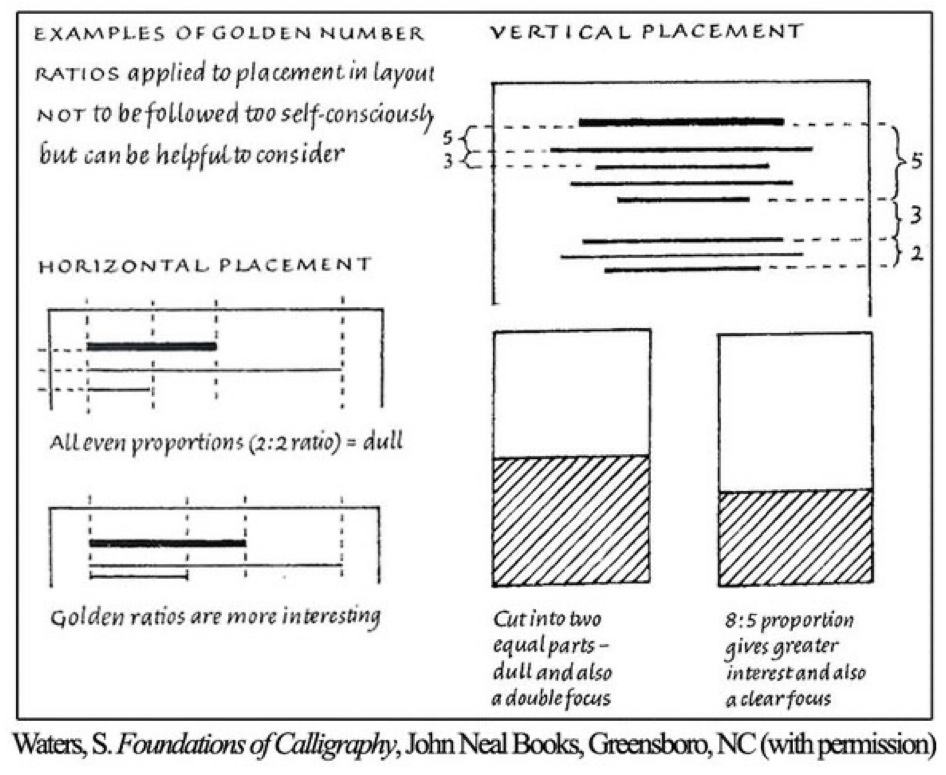
All of this information can inform our understanding of the plants we paint – both the plants themselves and the understanding of beautiful proportions in the layout on our paintings. Using the Golden Mean and associated Fibonacci numbers, thereby avoiding even proportions both vertically and horizontally, will help to keep paintings from appearing static and dull.
Fibonacci numbers can inform the numbers of foci in a painting – quantities of 1, 3 or 5 are generally perceived as more pleasing to the eye. Awareness of balance issues can help to avoid images that might appear out of proportion.
So now it might be helpful to see these principals in practice by applying them to an Orchid painting I created a few years ago. I believe that it is in reasonable Golden Section proportions. In addition to the general layout, it is also interesting to note that there are 5 large leaves, 3 smaller leaves and 3 flowers at the top. Also note that each orchid has 5 tepals and one lip…. All Fibonacci numbers!
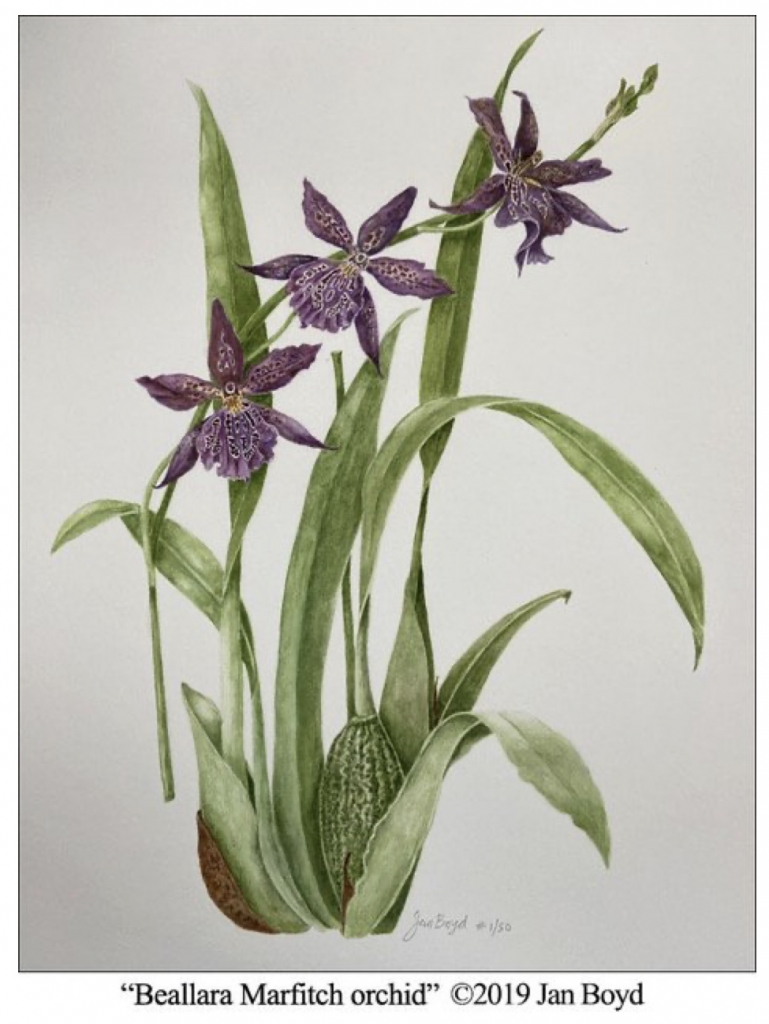
While the value of knowing these concepts may now be manifest, it is also wise that they not be followed slavishly in our field of fine art. “Perfect” faces, if we all had them, would look robotic and unnatural. Flowers and plants certainly have strong tendencies to conform to these concepts, but their variations are what make them interesting and always fascinating. The best use of Fibonacci numbers and the Golden Mean in botanical illustration, in my opinion, would be to be mindful of them when creating a piece of art and very alert to how they might help your analysis if you create or view a piece of art that seems “off” somehow.
www.janboyd.com
Fibonacci and the Golden Ratio as Applied to Botanical Work
by Jan Boyd
PART 1 OF 2
As artists, we often come across references to the related concepts of Fibonacci numbers and the Golden Mean. What do these terms mean, and are they useful in creating botanical artwork?
These concepts are quantifiable, identifiable and fascinating. They can be identified in and related to the beauty we find in flowers, trees, fruit and vegetables, in paintings, in sculptures, in music, in poetry, in the human body and more. For this short article I will concentrate on how they can impact our botanical artwork in a meaningful way.
For a more thorough presentation you can view my Youtube video.
Beauty is said to be in the eye of the beholder, but in studying the beauty of nature, art and architecture, we can discern a common principle – the universal experience of pleasant proportion. This basic understanding of proportion has been recognized since antiquity and named by philosophers and mathematicians variously as the Golden Proportion, Golden Ratio, Golden Section or Golden Mean. All these terms (which can be used interchangeably) represent what can be reduced to a mathematical equation, which identifies and quantifies proportions that please the eye. In everyday life we use the word “proportion” to indicate a comparative relationship between parts of entities with respect to size or quantity; parts of a picture, of an object or person, or of a building.
As seen in the pictures below, the use of the Golden Mean within a painting creates pleasing, proportional relationships. These relationships are characterized by pairings of Fibonacci numbers. Each relationship seen in the chart is a pair of Fibonacci numbers whose relationship to one another is approximately 1:1.618 (8 divided by 5 = 1.6, 5 divided by 3 = 1.666…). A Golden rectangle has sides that are in the Golden Ratio.
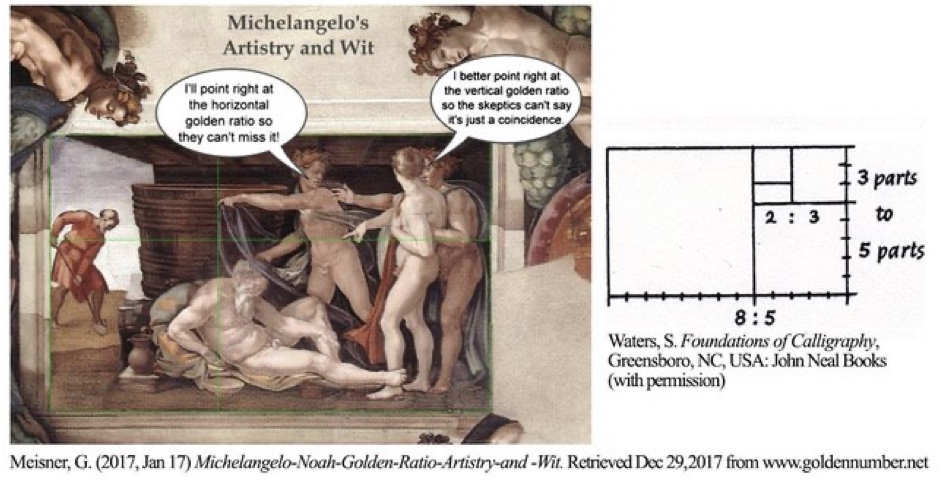
So where does Fibonacci come into this? At the dawn of the 13th century, the Middle Ages were fading and glimmers of the Renaissance were starting to appear. Leonardo Pisano, a brilliant Italian mathematician (later to be known familiarly as Fibonacci) wrote his most well-known work, Liber Abaci (Book of Calculating), in which he forever changed Western methods of calculation. In this treatise he raised the following hypothetical question that has become known as the first algebra word problem.
What would happen if a pair of rabbits were put into an enclosure to breed? How many pairs of rabbits will there be after a year if it is assumed that every month each pair produces one new pair, which begins to bear young two months after its own birth? It was not the answer 377 that was most interesting, but the emergence of the pattern by which this could be solved: 0, 1, 2, 3, 5, 8, 13 …… the string of numbers that begins with 0, 1 where each subsequent number is the sum of the previous two numbers. This is credited as the first known written record of what later became known as the Fibonacci sequence.
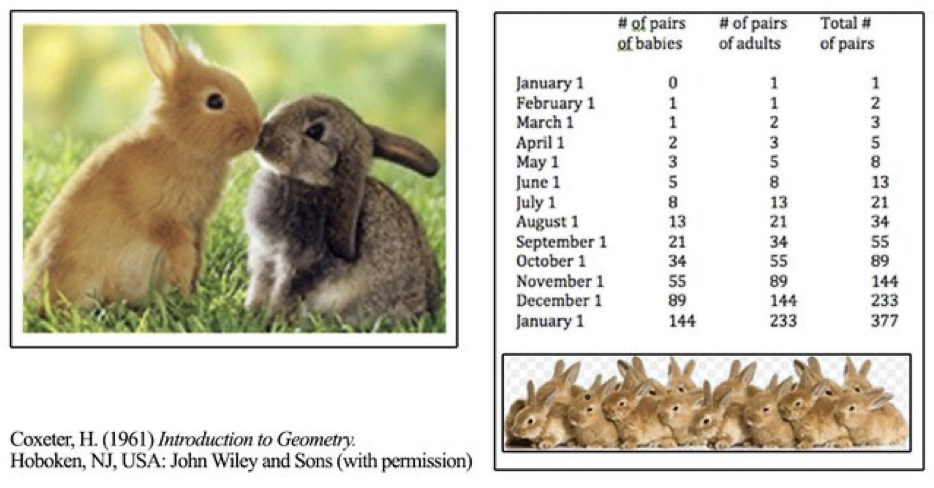
Over the centuries, mathematicians, botanists, artists and philosophers have noted the existence of this sequence in diverse disciplines from pine cones to poems, sunflowers to symphonies, ancient art to modern computers, the solar system to the stock market!
One of the most fascinating examples of the sequence in the animal kingdom is the spiral that characterizes much animal growth. The spiral below demonstrates the construction of the logarithmic spiral – a long slow spiral characterized by all radii from its center intersecting the spiral at exactly the same angle. Using the Fibonacci sequence, the spiral grows to accommodate the growing animal inside in a nautilus shell – and additional examples can be seen in the human ear and in the human fist.
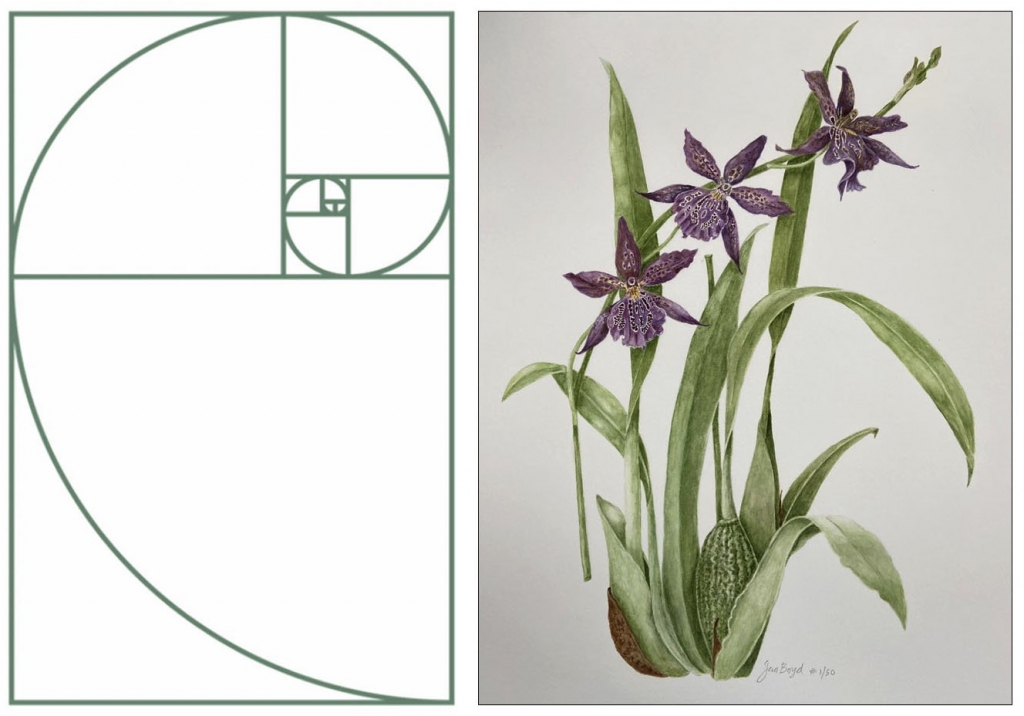
Another interesting note in animal growth and form is the presence of the Fibonacci number 5 and the Pentagon shape, which has Fibonacci elements, as can be noted in the diagrams below. The shape is visible in the radial symmetry of some plant and animal growth from starfish to sand dollars; from the 5-star pattern of carpels visible inside a transversely cut apple to sea urchins and 5-petaled flowers.
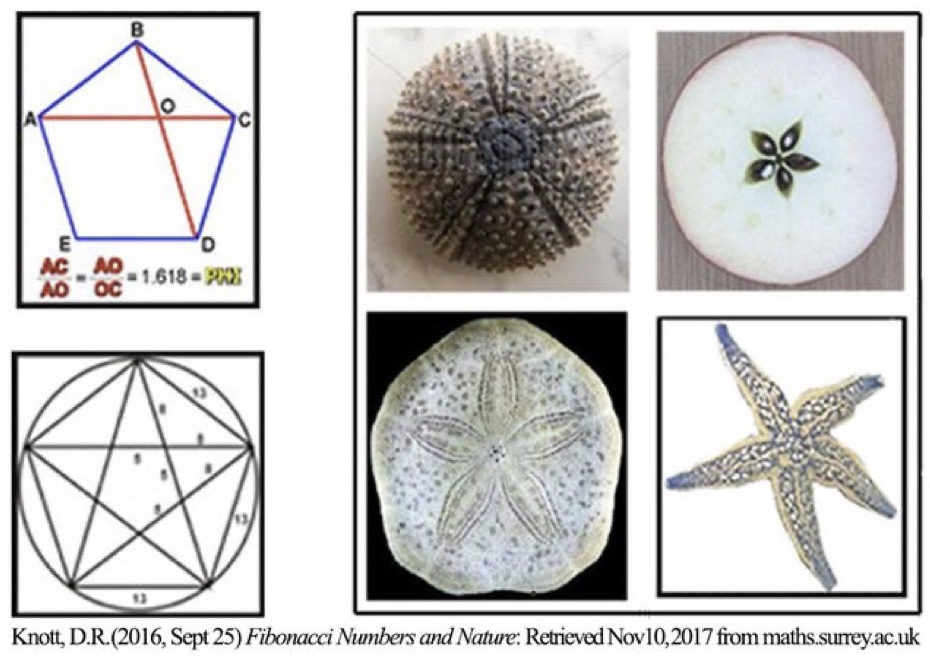
So how does all of this relate to the work we, as botanical artists, observe and illustrate? In external plant structure, botanists have found that Fibonacci numbers show up often in plants that have multiple parts (leaves, sepals, petals, etc.) arranged around a single stem. If you count the number of petals in the predominance of flowers, you will find that the total is a Fibonacci number. For example, an Iris has 3 petals, flowering quince has 5, and delphinium or cosmos have 8. A ragwort has 13 petals; an aster 21 and Michelmas daisies have 55 or 89.
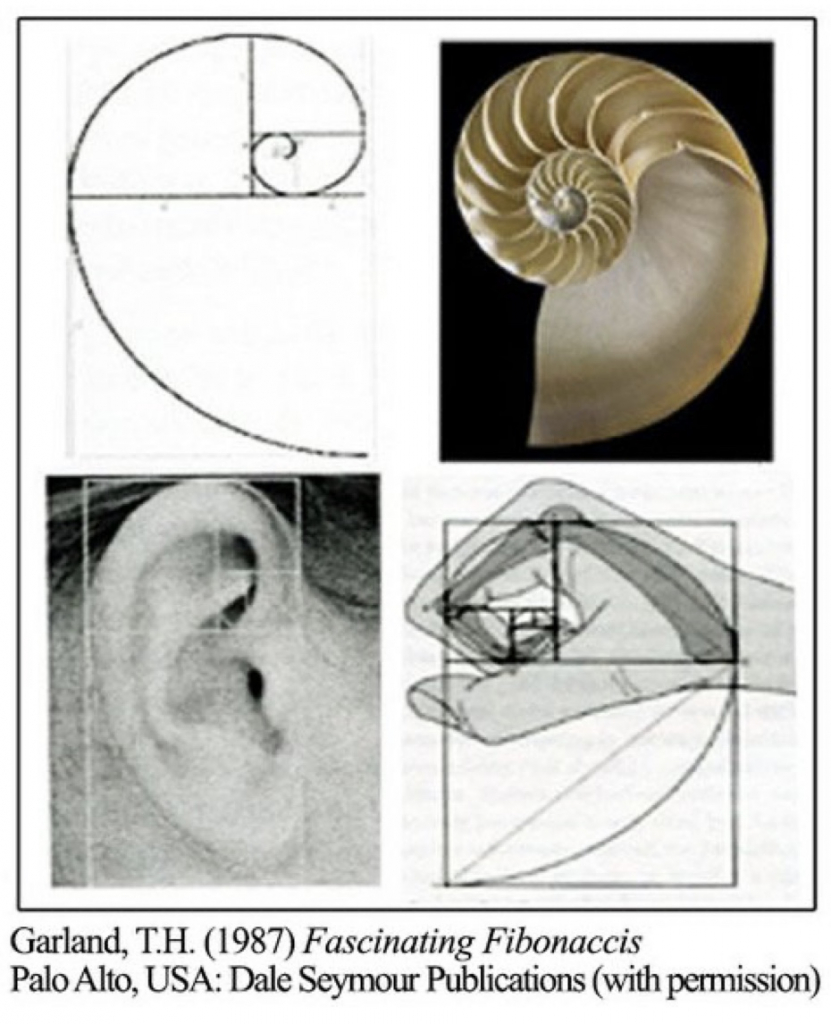
Internal growth patterns in plants also exhibit Fibonacci numbers. By examining the center of a sunflower, a pattern of two spirals is evident. In a typical sunflower there will be 21 or 34 running clockwise and 34 or 55 running counterclockwise – all Fibonacci numbers. The florets are packed into the tightest possible area that will allow each to receive optimal nutrients and sunlight. Pinecone growth shows that they typically have 5 or 8 clockwise and 8 or 13 counterclockwise spirals in the bracts that grow out of the stem.
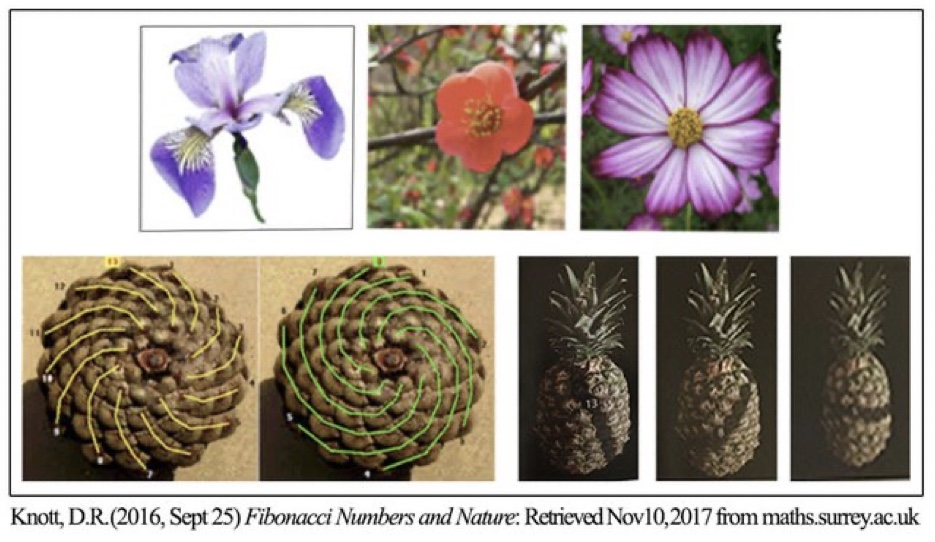
Plant growth patterns are another area where Fibonacci patterns can be observed. Plants grow toward sunlight, growing in spirals as they reach for moisture, sunlight and air, which are found to be available cyclically. The tip of a branch moves in a somewhat circular motion as it lengthens and grows. As a branch grows it generates leaves in fractions of a full turn of the branch (after 2/5 or 3/8 or 8/13th of a full cycle for example) rather than at equal intervals, so that new leaves are not directly over earlier growth, which would otherwise tend to deny them of the nutrients needed to continue to grow. These phyllotactic ratios (Phyllotaxis) are usually Fibonacci numbers. In the diagram below eight stems were produced in three complete growth spirals.
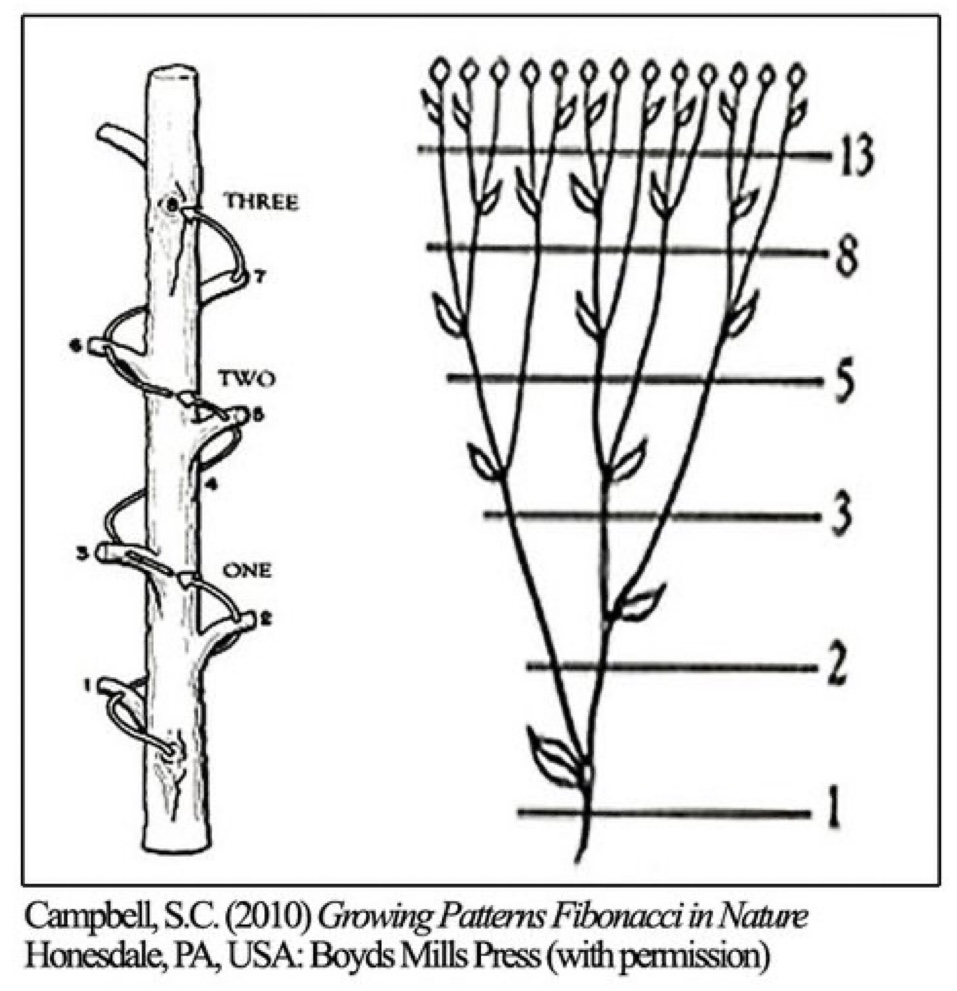
We now understand these principals in regard to plant growth and structure but there is one more very important aspect to consider as we create our illustrations – the appreciation of Fibonacci numbers and the Golden Mean as they relate to artistic layout. (To be continued.)
_________________________
We thank Jan for submitting this piece for our blog. Stay tuned for the second half of her article, where she shares how lessons learned from world renowned calligrapher, Sheila Waters, helped inform her understanding of layout in paintings as well as lettering.
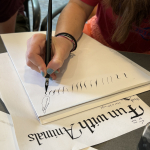
"Letters are Blooming" Calligraphy Demonstration and Book Gifting at the Westwood Public Library
If you were in Westwood last April (2023) you may have been fortunate enough to stop in and see our exhibit, “Hands Through Time” at the Westwood Public Library. True to our commitment to nurture learning, a lecture about the history of calligraphy, given by Diane Desautelle, was offered as the educational component that coordinated with the exhibit. Books on the topic of calligraphy and hand lettering were pulled from the library's collection and put on display for the event. The Masscribes Board later discussed that some of their favorite books were not owned by the library and voted to give them as a gift. The Board chose: Written Letters by Jaclyn Svaren, Foundations of Calligraphy by Sheila Waters and The Art and Craft of Hand Lettering by Annie Cicale. Paula Howard volunteered to create handmade bookplates. In May of 2024, the books and bookplates were delivered to the library for processing. A date was set in August for an official presentation of the books accompanied by a calligraphy demonstration open to Westwood Public Library patrons.
On the day of the Masscribes calligraphy demonstration, Paula Howard, Cathy Lauinger and Diane Desautelle arrived early to set up the Community Meeting Room, excited to share their passion for lettering. The gifted books were put on display along with some Masscribes brochures. As the curious public began to enter, our members took to the four corners of the room to demonstrate various techniques for dip pen lettering with both pointed and broad nibs, as well as modern calligraphy with markers. A station for creating bookmarks was a fun attraction for young and old alike. Visitors came from as far away as New Hampshire to try their hand at calligraphy. (Really!!) Each and every one of them expressed their excitement and gratitude for having a live person help them take the beginning steps toward better lettering and calligraphy. Our event was covered by Hometown Weekly. Check out their article here:
https://hometownweekly.net/westwood/calligraphy-workshop-at-wpl/
Welcome to Ink Spots ~ The Masscribes Blog
Those of you who have been Masscribes members for some years will surely remember our beloved issues of Ink Spots, the printed and snail-mailed newsletter that would surprise us in our mailbox a few times a year. It regularly included a personal and encouraging letter from the president (The President’s Pen), a humorous or sentimental letter from the editor, announcements of upcoming events in the larger calligraphy world, reports from study groups, book reviews, exhibit reviews, workshop reviews, images of work from private shows to holiday greeting cards, articles about tools and supplies, and so much more. With the increased costs of printing and postage, along with limitations on our time, the newsletter went digital for a while and then seemed to take a vacation during the Covid-19 pandemic. We hope to someday again distribute a full-color printed publication that you can hold in your hands – but in the meantime, the idea of a blog within our already existing website seems to fit the bill. Here, not only can we share all the same informative and entertaining content, but it is also a wonderful way to have things archived so that you can return to the site and easily find them again any time you like.
By way of the blog, Ink Spots shall live once more! We look forward to posting not only information from the executive board and committees but also articles or other small pieces contributed by members. Please contact us at info@masscribes.org.
Welcome and enjoy!
Diane Desautelle
Masscribes President
2021-2024
Tuesday Night Drop-in Calligraphy Art Group
For the past two years, members of Masscribes have been meeting via Zoom on Tuesday nights to create community, creative outlets, and beautiful pieces of art and calligraphy.
We’ve had our regulars as well as many new faces over time. As the title says, there is no pressure to attend every session, you participate when you can.
At first it was for us to gather and have company while we worked on whatever projects we had going in our home studios. Occasionally, we’ve had demos, including How to Fix Mistakes with Carole Roy, Creating Celtic Knotwork with Diane Desautelle and others.
Illuminated letters were one project that we worked on over two sessions. Over the next few weeks, we worked on a project with modern calligraphy as well as projects using shapes such as circles and brush calligraphy exploration. In April ‘23 we had a joint project for our Exhibition at the Norwood Public Library. We all chose the same palette of colors and wrote out the title of the show, Hands Through Time.
Look for updates on Instagram and Facebook on our Masscribes pages for images of projects by the Tuesday night group.
The Drop-In meetings are a nice, casual way to get to know other members. They also offer a safe environment for beginners to ask questions of more experienced calligraphers. New members are warmly welcomed! If you would like to join, please send an email to Rachel Diamond Calow at Rdcalow@aol.com.
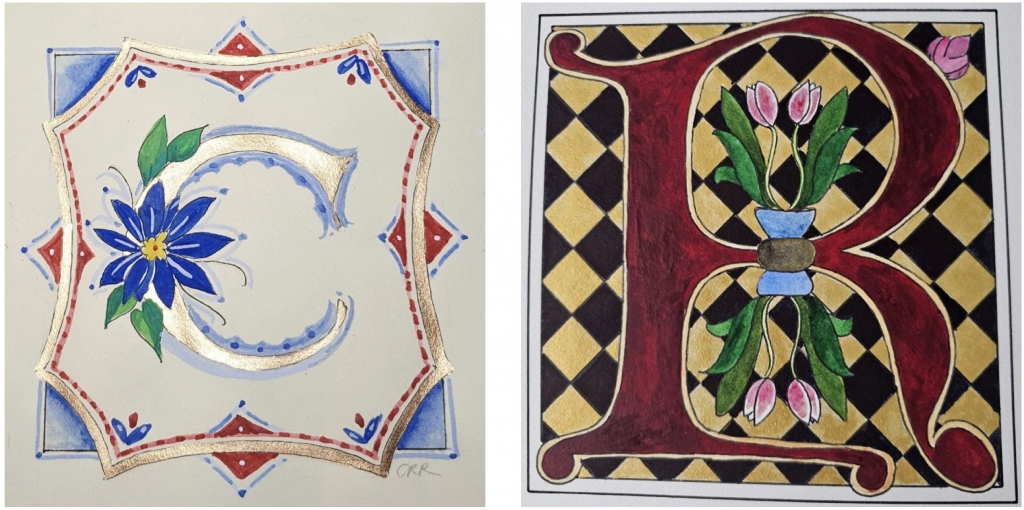
Illuminated Letters - Left image by Cindy Rudolph, right image by Rachel Diamond Calow
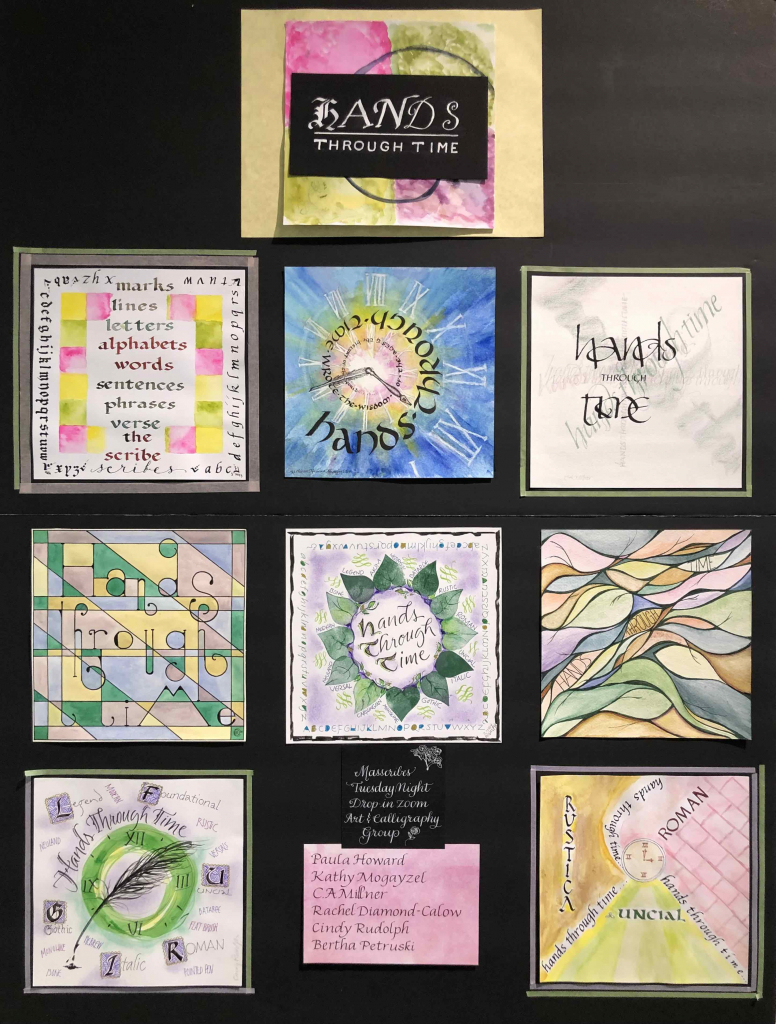
Hands Through Time images by Paula Howard, CA Millner, Bertha Petruski, Rachel Diamond Calow, Kathy Mogayzel and Cindy Rudolph
by Rachel Diamond Calow

| Masscribes is pleased to offer you these archived issues of our tri-annual newsletter, Inkspots. We invite all members to submit articles and images to use in our blog, ‘Inkspots’. | |
Downloadable Files:
|
